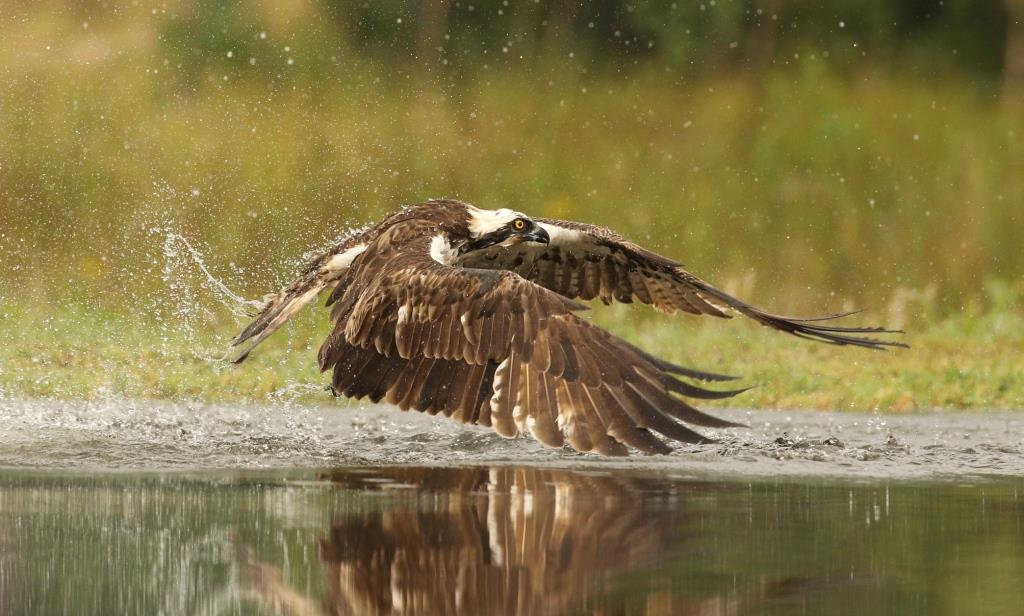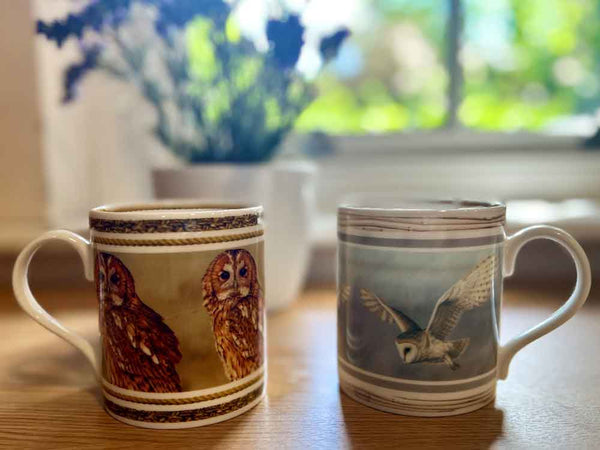
Osprey conservation
The comeback of the osprey has been one of the great conservation success stories of the twentieth century. Scotland welcomed back the first breeding pair in 1959 after ospreys had been absent there for 50 years. According to the Scottish Wildlife Trust, there are around 200 breeding pairs in Britain and Scotland is their main stronghold. These magnificent birds were driven out partly because they competed with anglers. So it is a sign of the times that a Scottish fishery – Rothiemurchus, near Aviemore – is now welcoming them with open arms.
Rothiemurchus ospreys
In fact it doesn’t just welcome them, it actually feeds them in to a specially designed pool so that wildlife enthusiasts can capture the moment when they splash down into the water to catch a trout. And would you believe it is so popular I had to book in a year in advance. So it was with great anticipation that I arrived in the Highlands. I headed out to the fishery straightaway to see where I would be photographing the following morning.
I passed by a series of lakes and could see why the ospreys come here. The waters team with plump trout. The osprey pool itself was about 25 metres round, shallow and well stocked with trout. On one side were the hides which have been purposely built just above the water level. I saw the unmistakable outline of an osprey overhead then another and then a third. I didn’t want to disturb any hunting so I backed off and went to ‘feed the fish’ with my wife and two children.
Inside the osprey hides
I was keen to have an early night as I had to be in the hide by 4.30am. But I had an unsettled night’s sleep, waking up to check my alarm clock every hour. By 3.45am I’d had enough and decided to get ready. I arrived at the fishery at 4am. It was still quite gloomy as I entered the hide, but there was already one osprey overhead.
I set up my camera equipment and looked around. Even though the pool was small it would be tricky to get my focusing right. Our guide had thrown out some fish food at the far side of the pool to make the trout gather together, so I set my lens on that spot. I realised that the hides had been designed with an overhanging roof to camouflage my presence from the birds, but this meant that I couldn’t see the sky or see the ospreys approach as they started to dive.
Osprey 'spotters'
But a solution to this had already been found. They positioned a spotter on the far edge of the fishery to let me know when an osprey was coming in via a walkie talkie. I smiled to myself – this was going to be easy. Unfortunately this was not quite the case. The osprey overhead turned out to be a very possessive male with the ring number ‘Red A8’ who had decided that this elaborately designed set up was for his own exclusive use. And I’d heard a worrying tale that this osprey hadn’t let a single other bird hunt in the pool the day before nor fished himself.
Osprey Red A8
As dawn broke other ospreys arrived on the scene and my heart sank as I heard Red A8 calling and chasing them away. By 6am Red A8 had chased a further 4 ospreys away, and the damn bird had been so busy he hadn’t even had chance to fish himself. Time was ticking on and I was aware the fishery opens to the public at 9.30am so there would be little hope of photographing ospreys after this time.
Then a crackle on the radio, the spotter with better news: “Osprey overhead.” Then a moment later: “Osprey still overhead.” Then seconds after: “Osprey diving.”
Photographing ospreys dive
I knew it was coming down but had no way of seeing the osprey until it was moments from hitting the water. Red A8 came in with speed and pulled out of the dive just before hitting the water. He flew off so fast I didn’t even have chance to train a camera on him. He had misjudged his dive and was circling overhead out of sight ready for another go. The radio crackled again, “Osprey diving” he plunged into the water and almost disappeared completely.
I trained my camera on the huge splash that he left behind. He re-emerged his long wings flapping down hard to get him up in the air and tiny water droplets flying off in all directions. He hadn’t caught a fish but at 10 frames a second my camera had managed to capture every wing beat. He was now fully airborne and shook his feathers mid-flight to get rid of the last of the water.
Red 8 is a spectacular creature
Wow, what a spectacle - even better than I could have imagined. I have seen ospreys dive before but this time I was just 25 metres away. I looked through my photographs on screen to check they were in focus. It was a good first attempt but the osprey was flying slightly away from me as he came out of the water due to the strong south westerly wind.
Watching how an osprey catches fish
The radio crackled again: ‘Osprey overhead’ then: ‘Diving’. It was a repeat of the first dive, but on his third attempt good old Red A8 had caught a large trout. He was being jerked, twisted and turned in the water by the fish and took a long time to get a good grip before taking off into the wind flying slightly away from me again. Two other ospreys arrived, possibly as they had seen that Red A8 had caught a fish. But Red A8 still tried to chase off his rivals even though he had a fish in his talons. Eventually he headed off with his catch which opened up the skies for other ospreys to come in.
More ospreys dive for trout
Three or four more ospreys finished off the morning’s watching with 19 dives between them and another three fish caught. The wind direction continued to be a problem I needed the birds to be either ‘side-on’ or coming towards me in order to make a good composition for a painting. This was the first morning of six sessions I had booked at the osprey hide. I had high hopes for the week ahead especially due to the forecast of a heat wave.
Osprey nest
On the second morning, a mist had descended but a change in wind direction meant I would capture better compositions. I had great sessions on day three and four in spite of Red A8 continuing to be a bit of a pest. Although he did at least keep the ospreys away from the pool until the light improved. I even started to feel a bit of affection towards him after I visited his nest with two large chicks on a nearby estate.
Not all Rothiemurchus ospreys fish so well
By the fifth morning I was starting to find it difficult to get up by 4am. It didn’t help that Red A8 was up to his clever tricks again. There was only one dive in the six hour session, which was quite a long wait. But on the sixth and final morning the action more than made up for the day before. The conditions were tricky however. The mist struggled to clear making it impossible for the spotter to see any ospreys through the gloom. So we were only alerted to the first incoming osprey by the huge splash it made as it plummeted into the water.
This particular bird hadn’t caught a fish so we knew it would be back. It turned out to be the most determined yet most unsuccessful diver that has been seen at Rothiemurchus. I played back the images on my camera I totted up that it had dived 25 times before it caught a single fish.
I was in the hide with seven other photographers when it finally succeeded and although we were supposed to be quiet we all let out a spontaneous cheer as it flew out of the pool with a fish in its talons. About time too!
This story featured in my Yorkshire Post column in 2013.














